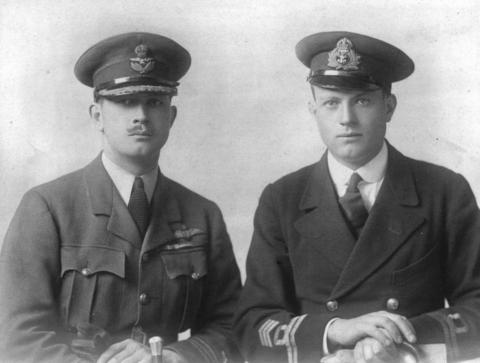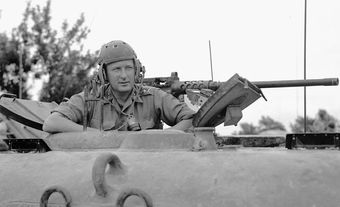Donald Roderick MacLaren, fighter pilot, war hero, businessman (born 28 May 1893 in Ottawa, ON; died 4 July 1988 in Burnaby, BC). A First World War fighter ace, MacLaren was credited with 54 air victories in less than eight months — an unparalleled record. He was one of the top ten aces of the war, and third among Canadians, after William “Billy” Bishop and Raymond Collishaw.

Early Life
Donald MacLaren was a son of Robert James and Mary Jeanie MacLaren. When he was a young child, his family moved to Calgary, then still a small frontier town. His father taught him how to use firearms, and Donald became skilled at shooting game birds for sport and food.
The family moved to Vancouver when he was 17. After graduating from secondary school, MacLaren decided to study electrical engineering. In 1912, he was admitted to McGill University in Montreal. He hadn’t completed his second year when he became ill and returned to Vancouver. Instead of going back to McGill to continue his studies, he remained in Vancouver, where he is believed to have taken a surveyor’s course.
With his father and his brother Roy, MacLaren moved to Keg River Prairie in northern Alberta and opened a fur-trading post. MacLaren found he was well-suited to the wilderness location, where travel was by horseback, canoe, foot and dogsled. In the autumn of 1916, after spending a summer in the far North with a government survey team, MacLaren returned home to find that Roy had joined the Canadian military to fight in the Great War, raging in Europe since 1914. In the spring of 1917, MacLaren and his father went to Vancouver to enlist. Robert was turned down due to his age, but Donald was accepted into the Royal Flying Corps.
Did you know?
During the First World War, more than 20,000 Canadians served with British flying services (Royal Flying Corps, Royal Naval Air Service or Royal Air Force). Canada didn’t have a permanent air force until 1924 (see Royal Canadian Air Force).
Off to War, 1917
MacLaren received pilot, gunnery and reconnaissance training at bases in Long Branch, Armour Heights and Camp Borden, Ontario. In August 1917 he received his pilot’s wings. He was sent to England for more intensive training in aerial tactics and manoeuvres. By that stage of the war, heavy losses in the air had convinced RFC commanders that improved combat training was vital to reducing casualties and gaining air superiority. MacLaren arrived in France in November. He was posted to No. 46 Squadron as a second-lieutenant, flying a Sopwith Camel.
MacLaren’s first three months at the Western Front were relatively quiet. He flew patrols and went on bombing raids, but the skies were practically empty of German aircraft. Allied pilots reported that the few enemy planes they did see avoided combat. The Germans were in fact attempting to conserve air personnel and machines as part of a planned major spring offensive. MacLaren did not engage in aerial combat until 6 March, when he shot down a Hannover plane. Four days later he shot down an Albatross DV fighter.
1918 German Offensive
The Germans launched their big push on 21 March 1918, hoping to win a decisive victory over the western Allies before American forces, having recently entered the war, could reach France. On that day, MacLaren participated in a bombing mission that destroyed a German long-range gun five or six miles inside enemy territory. On his return flight, he shot down two German fighters and an observation balloon. For that action he was awarded the Military Cross.
German aircraft now took to the skies in force. Day after day, MacLaren was in the thick of the dogfights — involving more than 100 planes in at least one case — that raged in the skies above the Western Front. He was a skilled pilot and deadly marksman. By the end of March MacLaren had 13 air victories, giving him the status of “ace” (an ace had five victories or more).
On 6 April, days after the Royal Flying Corps and the Royal Naval Air Service amalgamated into the Royal Air Force, MacLaren was promoted to captain. By the end of May, he had downed a total of 32 enemy aircraft, though on one occasion he had to make a forced landing after his plane was badly damaged by anti-aircraft fire. MacLaren had a bar added to his Military Cross for what his commanding officer called “magnificent bravery and absolute fearlessness.”
Last Months of the War
In June and July 1918, during the last significant German offensive of the war, MacLaren shot down nine more aircraft. His accumulation of air victories continued in the weeks during the Allied counter-offensive that broke the German lines and brought about the Armistice of 11 November.
By the time the fighting ended, MacLaren had 54 air victories to his credit — tied for the sixth highest among Allied air aces, and third among Canadians, after Billy Bishop and Raymond Collishaw. In addition to his Military Cross and bar, MacLaren was awarded the Distinguished Service Order and the Distinguished Flying Cross. The French government also made him a chevalier of the Legion of Honour and awarded him the Croix de Guerre.
Asked if he felt any remorse for the men who had died in the planes he shot down, MacLaren replied: “The first time I saw two Germans being carried away from their machines, which we had brought down behind our lines, I did feel it very keenly. But the feeling that was uppermost with us was a great love of our own fellows, and we knew well that every Hun who got away might kill one or more of our comrades later on.”
Did you know?
The term “ace” (or flying ace) refers to a military aviator who has shot or forced down at least five enemy aircraft. In total, there were nearly 200 Canadian aces during the First World War. Four Canadians were credited with at least 50 victories and were among the top 12 aces overall: Billy Bishop, Raymond Collishaw, Donald MacLaren and Billy Barker.

Postwar Life
In 1919, MacLaren was promoted to major. He helped establish the fledgling Canadian Air Force (CAF), serving as the director of air services and the Canadian liaison officer at Britain’s air ministry. He resigned from the CAF in 1920 to go into commercial aviation.
Back in Vancouver, MacLaren started his own company, Pacific Airways Ltd. It was a one-man operation with a single flying boat. In this role, MacLaren carried out work for the provincial and federal governments, flying fishery patrols and conducting aerial surveys. In 1926, MacLaren was instrumental in the formation of private flying clubs. These would relieve the RCAF of the task of overseeing many aspects of civilian aviation, while at the same time providing a body of pilots upon which it could draw in the event of war. As the commercial air business developed, MacLaren held various positions with Western Canada Airways, Canadian Airways and Trans-Canada Airlines.
During the Second World War, MacLaren helped establish the Air Cadet League of Canada and became its president in 1944. In 1977, he was inducted into the Canadian Aviation Hall of Fame.
MacLaren died at the age of 95. His medals are now held by the Canadian War Museum in Ottawa.
See also The Great War in the Air.

 Share on Facebook
Share on Facebook Share on X
Share on X Share by Email
Share by Email Share on Google Classroom
Share on Google Classroom
